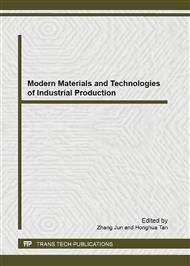[1]
Habrouk M, Darwish M K. Design and Implementation of a Modified Fourier Analysis Harmonic Current Computation Technique for Power Active Using DSPs [J]. IEE Proc Electr Power Appl, 2001, 148 (1): 21-27.
DOI: 10.1049/ip-epa:20010014
Google Scholar
[2]
Dixon J W, Garcia J, Moran L. Control System for Three Phase Active Power Filter which Simultaneously Compensates Power Factor and Unbalanced Loads[J]. Trans on Industrial Electronics, 1995, 42(6): 636-641.
DOI: 10.1109/41.475504
Google Scholar
[3]
Wang S Y, Hong C M, Liu C C. Design of a Static Reactive Power Compensator Using Fuzzy Sliding Mode Control [J]. International Journal of Control, 1996, 63(2): 393-413.
DOI: 10.1080/00207179608921849
Google Scholar
[4]
Mattavelli P. A Closedloop Selective Harmonic Compensation for Active Filters[J]. IEEE Trans on Industry Application, 2001, 37(1): 81-89.
DOI: 10.1109/28.903130
Google Scholar
[5]
Zhang Zhongchao, Ooi B T. Multi modular Current Source SPWM Converter for SMES [J]. IEEE Trans. PE, 1993, 8(3): 250-256.
Google Scholar
[6]
Wojciak P F, Torrey D A. The Design and Implementation of Active Power Filters Based on Variable Structure System Concepts [C]. IEEEIAS Annual Meeting Conference Record, 1992: 950-957.
DOI: 10.1109/ias.1992.244308
Google Scholar
[7]
Dixon J, Contardo J, Moran L. DC Link Control for an Active Power Filter, Sensing the Line Current Only [C]. IEEE Ann PESC, IllinoisIEEE, 1997: 1109-1114.
DOI: 10.1109/pesc.1997.616887
Google Scholar
[8]
Chen Y M, Connell R M. Active Power Line Conditioner with a Neural Network Control [A]. IEEEIAS Annual Meeting Conference Record, California IEEE, 1996: 2259-2264.
Google Scholar
[9]
Juan A Martinez, Ferley Castro2Aranda. Lightning performance analysis of overhead transmission lines using the EMTP [J]. IEEE Trans on Power Delivery, 2005, 20(3): 220022210.
DOI: 10.1109/tpwrd.2005.848454
Google Scholar
[10]
Takemitsu Ito, Hideto Watanabe, and Toshihisa Funabashi, et al. Lightning flashovers on 772kV systems: observed voltage bias effects and analysis [J]. IEEE Trans on Power Delivery, 2003, 18(2): 5452550.
DOI: 10.1109/tpwrd.2003.809683
Google Scholar
[11]
Gerhard Diendorfer. Induced voltage on an overhead line due to nearby lightning [J]. IEEE Trans on EMC, 1990, 32(4): 2922299.
DOI: 10.1109/15.59889
Google Scholar
[12]
Akagi H, Fujita. A new power line conditioner for harmonic compensation in power systems [J]. IEEE Trans on PWRD, 1995, 10(3): 157021575.
DOI: 10.1109/61.400941
Google Scholar
[13]
Fujita H, Akagi H. A practical approach to harmonic compensation in power systems2series connection of passive and active filters [C]. IEEE IAS Annual Meeting Conference Record. Orlando, USA, 1990: 11071112.
DOI: 10.1109/ias.1990.152323
Google Scholar


